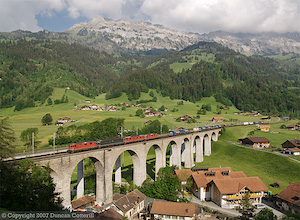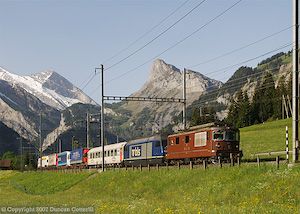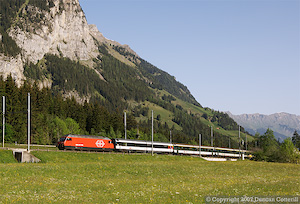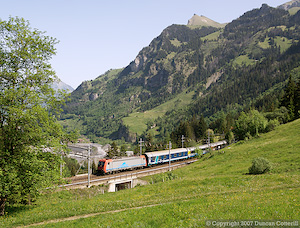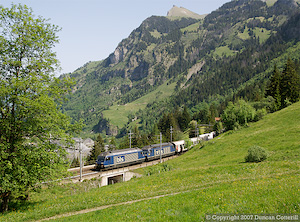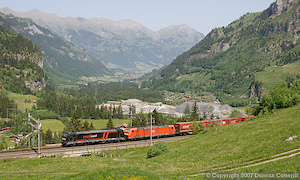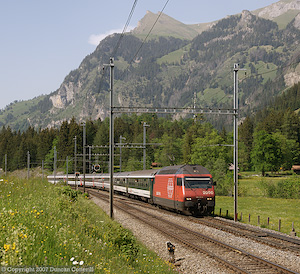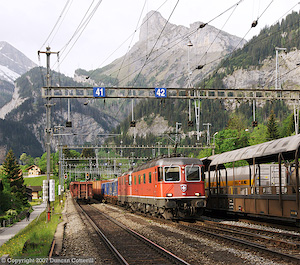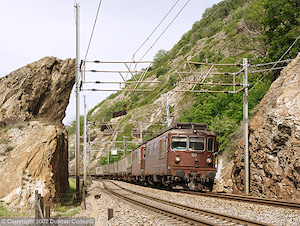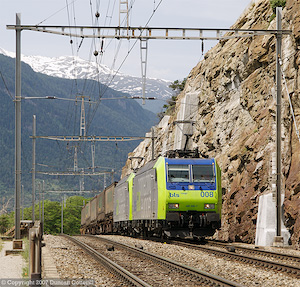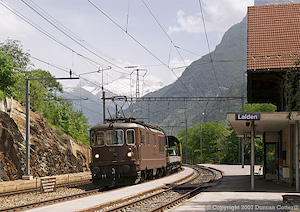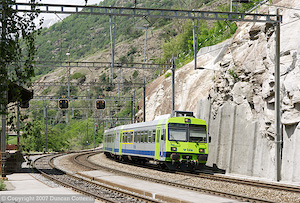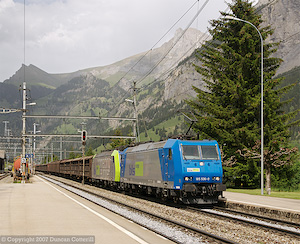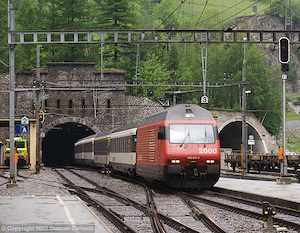Last Chance for the Lötschberg
23 - 27 May 2007
Report by Duncan Cotterill
Introduction
The Lötschberg main line is a busy freight and passenger route across the Swiss Alps. As well as being a major trunk route, it’s a scenic delight and a real engineering marvel. Seven years had passed since my last visit and the imminent opening of the 35.6 km Base Tunnel provided the impetus for a return in May 2007 while the original route was still busy. The Base Tunnel will bypass the most scenic section of the old line and is expected to take increasing volumes of freight traffic after its official opening on 16 June 2007. Passenger trains will be diverted through the new tunnel from December 2007.
My base for the trip was the Hotel zur Post in Kandersteg, a friendly little place, convenient for the station and very reasonably priced at SFr49 a night for a single room. As you would expect in Switzerland, excellent English is spoken. Trains, BLS’s own bus service and plenty of walking were used to get to the photo locations.
Getting There
I flew with Swiss from Heathrow to Zürich then travelled by direct train from the airport to Kandersteg. Getting through Heathrow was an ordeal and a half as the baggage system had failed and everyone had to queue down a rabbit hole to give their luggage to the one bloke in the entire terminal who was handling bags. I got in fairly early but still had to queue for well over an hour to get rid of my bag and finally handed it over at the time my flight was due to depart. What those of us in the queue weren’t told was that the main baggage system had been working again for some time and those who had arrived later had checked in as normal. There were no announcements and no special arrangements to fast track those of us who had been delayed through security. I finally got to the plane over half an hour after it should have departed but they didn’t wait for everyone. No doubt BAA will offer those who were left behind suitable compensation (fat chance!). Arrival at Zürich was around 45 minutes late. Over in Switzerland everything was working a lot more smoothly and the rest of the journey went according to plan.
The Lötschberg Main Line
The Lötschberg main line is owned and operated by the Bern Lötschberg Simplon Railway (BLS), Switzerland’s largest independent railway company. The line is double track throughout and carries heavy passenger and freight traffic, much of it in transit between Germany and Italy.
Trains from the north enter BLS territory at Thun, south east of Bern, and run along the south shore of the Thuner See (Lake Thun) to Spiez, where the Lötschbergbahn proper starts. The line runs south along the Kander Valley (Kandertal), climbing all the way through Reichenbach and Frutigen where the gradient steepens to 1 in 37. South of Kandergrund the valley floor rises abruptly at Mitholz and the railway is forced to double back on itself in order to gain sufficient height to reach Kandersteg at the head of the valley. From Kandersteg, the route south is blocked by a solid wall of mountains and the line’s builders were forced to bore the 14.6 km Lötschberg tunnel to reach the Rhone Valley. From the south portal at Goppenstein the railway briefly clings to the precipitous side of the Lötschental before emerging high on the north side of the Rhone Valley. The descent to Brig is largely on a ledge carved into steep, rocky mountainsides with plenty of tunnels and some impressive viaducts. It offers passengers spectacular views of the valley and the mountains beyond. From Brig, access to northern Italy is gained via the Simplon Tunnel.
Photography
In spite of the fabulous scenery and the frequent trains, the Lötschberg isn’t the easiest line to photograph. Much of the line is cut into steep rocky hillsides with sheer rockfaces above and precipitous drops below. Where the railway does run along the valley floor north of Blausee-Mitholz, it’s closely paralleled by an ugly power line that’s so close to the track that it’s impossible to keep it out of the shots. There are lineside footpaths on both the north and south ramps but they either seem to be right up close to the trackside or out of sight of the line altogether. There are remarkably few places where you can get a few metres back from the line to include much landscape in the picture. Excellent locations can be found but not as many as you might think.
The weather could best be described as changeable. Wednesday afternoon was fairly sunny and Thursday was glorious from start to finish but then things went downhill rapidly. There were a couple of hours of hazy sunshine in the middle of the day on Friday but Saturday was a complete write off and Sunday wasn’t much better. As a result I got most of the shots I was after on the north ramp but very little on the south side, which I planned to do on Friday and Saturday when extra car shuttles were operating.
Not to be missed locations include ...
* The Kander viaduct just over one km south of Frutigen station from the field beneath the Tellenburg ruins (mid-afternoon onwards).
* Looking down Kandertal from just off the “Höhenweg Nordrampe” footpath about 2 km north of Kandersteg station (mid-morning until early afternoon).
* Luogelkin Viaduct, about 1 km along the “Höhenweg Südrampe” footpath from Hohtenn station (from sunrise until about 09:45 only – take a very wide-angle lens).
* Bietschtal Bridge also on the “Höhenweg Südrampe” footpath between Hohtenn and Ausserberg (from mid-morning to mid-afternoon).
Passenger Trains
The main passenger service over the Lötschberg consists of hourly Inter City trains from Brig to Bern and v.v. calling at the main intermediate stations of Frutigen, Kandersteg and Goppenstein. These trains are operated by SBB and are usually formed of single-deck push-pull sets with a class 460 loco at the Brig end. Most continue beyond Bern to or from either Basel or Romanshorn. Another SBB Inter City service operates from Basel to Brig at two hourly intervals with a number of trains continuing to Milano via the Simplon tunnel. These trains run non-stop between Spiez and Brig. The through trains to or from Italy are numbered in the EC series and hauled by Cisalpino liveried class 484 locos except for one pair numbered CIS45 and CIS46 and worked by ETR470 tilting EMUs. The shorter workings are generally formed of single-deck push-pull sets with a class 460 loco at the Brig end. Exceptions to the “class 460 at the Brig end of a push-pull set” rule (apart from the Cisalpinos) are shown below. Note that these are only what I saw, not the official diagrams!
Southbound Trains
Train No. |
Spiez dep |
Brig arr |
Loco |
Remarks |
IC861 |
09:38 |
10:42 |
460 |
Mid-Train every day |
IC1069 |
12:10 |
13:06 |
460 |
Propelling (M-F only) |
IC873 |
13:38 |
14:42 |
Re4/4 |
Hauled every day |
IC824 |
14:38 |
15:42 |
460 |
Mid-Train on Sa only |
EC91 |
16:10 |
17:06 |
460 |
Hauled every day |
IC881 |
17:38 |
18:42 |
460 |
Mid-Train M-F (not seen Sa-Su) |
Northbound Trains
Train No. |
Brig dep |
Spiez arr |
Loco |
Remarks |
EC90 |
10:18 |
11:22 |
Re4/4 |
Hauled M-F+Su (was a 460 on Sa) |
IC1072 |
10:54 |
11:50 |
460 |
Mid-Train |
IC1080 |
14:54 |
15:50 |
Re4/4 |
Hauled every day |
IC886 |
16:18 |
17:22 |
460 |
Mid-Train M-F (not seen Sa-Su) |
IC890 |
18:18 |
19:22 |
460 |
Hauled (only seen on We) |
There are also BLS local trains serving stations between Spiez and Frutigen and between Goppenstein and Brig. These services follow a basic hourly pattern but there are several two hour gaps in the Goppenstein service. Two class 566.2 EMUs handled these workings and swapped round each night so the unit working the Brig – Goppenstein trains one day would work the Spiez – Frutigen service the next. There is no local train service between Frutigen, Kandersteg and Goppenstein but BLS buses from Frutigen serve intermediate stops to Kandersteg, again at hourly intervals.
Freight Trains
The Lötschberg route forms part of one of Europe’s main freight corridors and links France and Germany with Italy. Freight traffic is heavy, particularly intermodal trains of various sorts including RoLas, containers, swap bodies and lorry trailers. There are also significant amounts of general freight, wood chips, new cars, china clay and oil tanks.
Although the line is owned by BLS, open access and co-operative agreements mean that several operators’ locos can be seen. Motive power is refreshingly varied with a number of different classes appearing regularly. These include BLS classes 465, 485, 185 and 425 (Re4/4), SBB Cargo classes 420 (Re4/4) and 620 (Re6/6) (usually working as Re10/10), Crossrail classes 420 (Re4/4) and 185 and DB class 185. Most trains were double headed by locos of the same type but several BLS Re4/4 + 465 and BLS 485 + 185 combinations were seen and there was one instance of DB and Crossrail 185s double heading.
Timings were fairly erratic and unpredictable with many of the identifiable trains appearing at different times each day. Freights often followed shortly after the passengers but they could turn up at any time. Congestion around the Lötschberg tunnel could cause delays, particularly at the weekend when there were 6 or 7 car shuttles an hour to fit in as well as the main line passenger and freight traffic. On average there was one freight each way every hour but there were long gaps and also periods of frantic activity.
There is no road over the Lötschenpass so BLS runs regular car carrying shuttles through the Lötschberg Tunnel between Kandersteg and Goppenstein. These trains are formed with a driving trailer at the south end, an Re4/4 at the north end and a number of car carriers in between. Trains shuttle back and forth at intervals of 30 minutes with additional trains running at busy periods. Car shuttles also run through from Kandersteg to Iselle, south of the Simplon Tunnel in Italy, but only on busy weekends from May to October. The Goppenstein trains are difficult to photograph, as they don’t venture far out of the tunnel, but the Iselle workings can be seen anywhere on the north ramp.
The Base Tunnel
The Lötschberg Base Tunnel is due to open on 16 June 2007 and will begin to siphon off freight trains from that date. Traffic is expected to build up until December 2007 when passenger trains will be diverted through the new tunnel as well. Trains from the north can follow the existing route to Frutigen and then enter the tunnel at Tellenfeld, just south of Frutigen station. Alternatively, they can leave the old route at Wengi-Ey, between Reichenbach and Frutigen, and run through a new cut and cover tunnel to Tellenfeld, where the line emerges briefly before entering the main tunnel. At the south end, the tunnel emerges into the Rhone valley at a low level and joins the SBB main line near Raron, west of Visp.
Although the original plan was for a double track line throughout, the northern two thirds of the base tunnel will initially be single track with no passing loops. No date has been set for the completion of the second bore and double tracking the remainder of the route. With one or two passenger trains each way an hour, the capacity to handle freight trains will be limited and some freights will continue to run via the original route.
According to publicity leaflets available at stations in the area, all Inter City and Euro City services will run via the base tunnel from December 2007 and a new hourly BLS Regio Express service will serve intermediate stations between Spiez and Brig via the old line. For the first year these trains will be loco hauled but new EMUs are due to take over from December 2008.
Conclusions
Europe’s mountain main lines are under threat from a wave of base tunnel construction that will see many of the most scenic routes bypassed over the next 20 years. This is all very well if you just want to get from A to B as quickly as possible but many train passengers in the Swiss Alps want more from train travel than simple transportation. It remains to be seen how many of the thousands of leisure travellers who ride over the Lötschberg each month will want to look at 34.6 km of bland concrete wall instead of feasting their eyes on the magnificent scenery visible from the original line. Hopefully SBB will come to their senses and continue to route some express trains via the original line, leaving the base tunnel to the soulless few who don’t care what they see out of the window.
The base tunnel is a disaster photographically but with single track for two thirds of its length, it’s likely to become a bottleneck fairly quickly. There is a realistic hope that a significant number of freights will continue to use the old line due to the limited capacity of the new tunnel. The loco hauled Regio Expresses promised for the first year of operation should be an attraction in themselves, especially if they’re powered by the classic BLS Re4/4s.
Meanwhile, there’s still likely to be enough traffic over the original line to justify a visit for the remainder of this year.
As this was my first visit since 2000, it was interesting to see what had changed and what hadn’t. The domination of passenger services by class 460s was not unexpected but the relative rarity of locos in advertising liveries (almost uniformly hideous) was a pleasant surprise. It was also nice to see that a few trains continued to be hauled by SBB Re4/4s.
On the freight side, the sheer number of different liveries was welcome. Even though many of the locos were variants of the ubiquitous Bombardier Traxx (DB 185) design, they're not bad looking engines and the paint schemes add variety. The SBB Cargo locos looked remarkably uniform in contrast to the other operators’ engines. Everything was plain red apart from a single loco in the superb new SBB Cargo red/blue livery and a few still in vintage green. The single daily Ae6/6 working proved impossible to photograph on the north ramp as it appeared just after the sun had dropped behind the mountains.
Also notable was that none of the BLS’s ex SBB Re4/4s were seen, except on the depot at Spiez. The 465s seemed to be favourites for the RoLa trains and shared the bulk of the BLS freight work with the 185s and 485s. Everything else was worked by the classic BLS Re4/4s, including all the car shuttles through the Lötschberg Tunnel.
The Swiss transport system was a joy to use with direct trains from Zurich and Geneva airports to most parts of the country, good connections to everywhere else and punctual operation. I used one of the new one-country Inter-Rail tickets and got the impression that it was the first that most grippers had seen, judging by the way they looked at it. There weren’t any problems though and it worked out significantly cheaper than the equivalent Swiss Pass. The standards of timekeeping don’t seem to have slipped over recent years and most trains are long enough to comfortably accomodate everyone who wants to use them.
There was one aspect of the rail service that struck me as summing up the quality of Swiss railways very well: The hourly Brig - Goppenstein local service takes 26 minutes in each direction and is operated by a single unit with 4 minute turnrounds at each end. How many other railways could even contemplate doing that?
